View in other NatureServe Network Field Guides
NatureServe
Montana
Utah
Wyoming
Idaho
Wisconsin
British Columbia
South Carolina
Yukon
California
New York
Pasture Grasshopper - Melanoplus confusus
Other Names:
Pasture Spur-throat Grasshopper
General Description
Taken from Brooks (1958), Vickery and Kevan (1985), Pfadt (2002), Capinera et.al. (2004), Capinera and Sechrist (1982), and Scott (2010). A small to medium-sized, dull-drab yellowish-brown grasshopper. The underside of the body is cream colored. A dark stripe on the side of the head and pronotal lobe is usually black and shiny.
Phenology
Overwinters in the egg stage and one of the first grasshoppers to hatch in early spring (April). Hatching continues for a month and the nymphs pass through 5 instars, becoming adults in 40 to 46 days. Adults start to appear in early June and are present through July (Pfadt 2002, Capinera and Sechrist 1982).
Diagnostic Characteristics
The following is taken from Brooks (1958), Vickery and Kevan (1985), Pfadt (2002), Capinera et.al. (2004), Capinera and Sechrist (1982), and Scott (2010). Body length for males is 16 to 20 mm, females 19 to 27 mm. Wings (tegmina) are long, slender and uniformly colored. The males wings extend beyond the hind femur knee (apices), the females reaching the apices. Outer face of the hind femur often lacks any conspicuous banding, but the underside is orange or sometimes yellow. The hind tibia is greenish-blue, sometimes yellowish or reddish at the tip.
Any number of Melanoplus species can be confused with this species without collecting male specimens for genitalia comparisons to make positive identifications.
Species Range
Montana Range
Range Descriptions
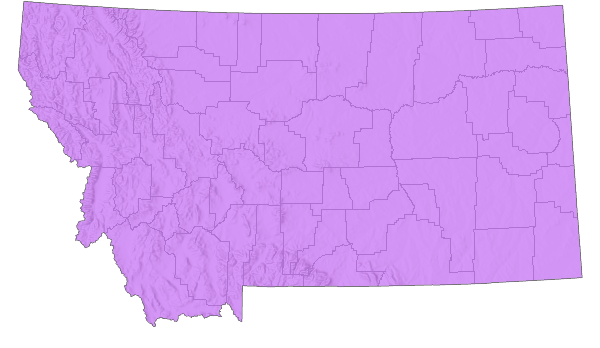
 Native
Native
Range Comments
This species is found throughout the U.S. from New England to British Columbia, Canada, and south to North Carolina, Oklahoma and Arizona. In Montana, there are confirmed reports for 20 counties, east to west and north to south in the state (vickery and Kevan 1985, Capinera et al. 2004, Capinera and Sechrist 1982, Scott 2010).
Observations in Montana Natural Heritage Program Database
Number of Observations: 22
(Click on the following maps and charts to see full sized version)
Map Help and Descriptions
Relative Density
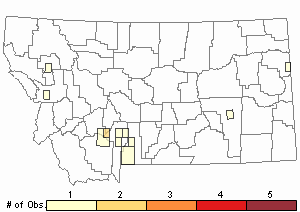
Recency
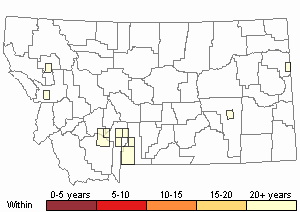
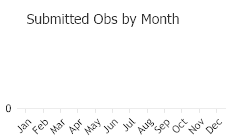
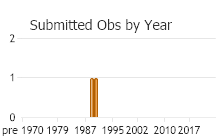
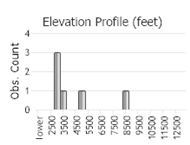 (Observations spanning multiple months or years are excluded from time charts)
(Observations spanning multiple months or years are excluded from time charts)
Habitat
Inhabits prairie grasslands in the West and meadows and pastures in the East, as well as roadsides, cultivated field borders and open grass areas in woodlands. Prefers areas with sandy to gravelly soils (Pfadt 2002, and Capinera and Sechrist 1982).
Food Habits
The following is taken from Pfadt (2002), and Capinera and Sechrist (1982). The Pasture Grasshopper is polyphagous but seems to prefer forbs over grasses. Some studies have indicated that this species diet consists of 22% to 49% grasses and 45% to 100% forbs. Some preferred forb species include
western ragweed (
Ambrosia psilostachya), wild buckwheat,
white sagebrush (
Artemisia ludoviciana),
prairie spiderwort (
Tradescantia occidentalis),
flatspine stickseed (
Lappula occidentalis) and
wavyleaf thistle (
Cirsium undulatum). Grasses include
cheatgrass (
Bromus tectorum),
Japanese brome (
Bromus japonicus),
western wheatgrass (
Elymus smithii) and
Kentucky bluegrass (
Poa pratensis). Other foods consumed include pollen, fungi and various arthropod body parts.
Reproductive Characteristics
The Pasture Grasshopper is one of the earliest species to begin egg laying (oviposition). It prefers to lay eggs in the shade of shrubs and tall forbs. The female lays eggs in bare ground or in the sod of
buffalo grass (
Buchloe dactyloides) or
blue gramma (
Bouteloua gracilis). The eggs are laid relatively deep into the soil, one inch or less. She deposits 10 to 15 eggs per pod (Pfadt 2002).
Stewardship Responsibility
References
- Literature Cited AboveLegend:
 View Online Publication
View Online Publication Brooks, A.R. 1958. Acridoidea of Southern Alberta, Saskatchewan, and Manitoba (Orthoptera). The Canadian Entomologist (Supplement 9) 90:5-92.
Brooks, A.R. 1958. Acridoidea of Southern Alberta, Saskatchewan, and Manitoba (Orthoptera). The Canadian Entomologist (Supplement 9) 90:5-92. Capinera, J.L. and T.S. Sechrist. 1982. Grasshoppers of Colorado: Identification, Biology, and Management. Fort Collins, CO: Colorado State University Experiment Station, Bulletin 584S. 161 p.
Capinera, J.L. and T.S. Sechrist. 1982. Grasshoppers of Colorado: Identification, Biology, and Management. Fort Collins, CO: Colorado State University Experiment Station, Bulletin 584S. 161 p. Capinera, J.L., R.D. Scott, and T.J. Walker. 2004. Field Guide to Grasshoppers, Katydids, and Crickets of the United States. Ithaca, NY. Cornell University Press.
Capinera, J.L., R.D. Scott, and T.J. Walker. 2004. Field Guide to Grasshoppers, Katydids, and Crickets of the United States. Ithaca, NY. Cornell University Press. Pfadt, R.E. 2002. Field Guide to Common Western Grasshoppers, 3rd edition. Laramie, WY: Wyoming Agricultural Experiment Station, Bulletin 912, modified by S. Schell and S. Schell for electronic publication. Accessed 19 February 2020. http://www.uwyo.edu/entomology/grasshoppers/field-guide/index.html#fieldguidetoc
Pfadt, R.E. 2002. Field Guide to Common Western Grasshoppers, 3rd edition. Laramie, WY: Wyoming Agricultural Experiment Station, Bulletin 912, modified by S. Schell and S. Schell for electronic publication. Accessed 19 February 2020. http://www.uwyo.edu/entomology/grasshoppers/field-guide/index.html#fieldguidetoc Scott, R.D. 2010. Montana Grasshoppers, Katydids, and Crickets A Pictorial Field Guide to the Orthoptera. MagpieMTGraphics, Billings, MT.
Scott, R.D. 2010. Montana Grasshoppers, Katydids, and Crickets A Pictorial Field Guide to the Orthoptera. MagpieMTGraphics, Billings, MT. Vickery, V. R. and D. K. M. Kevan. 1985. The grasshopper, crickets, and related insects of Canada and adjacent regions. Biosystematics Research Institute, Ottawa, Ontario. Publication Number 1777. 918 pp.
Vickery, V. R. and D. K. M. Kevan. 1985. The grasshopper, crickets, and related insects of Canada and adjacent regions. Biosystematics Research Institute, Ottawa, Ontario. Publication Number 1777. 918 pp.
- Additional ReferencesLegend:
 View Online Publication
View Online Publication
Do you know of a citation we're missing? Anderson, N.L. 1962. Grasshopper-vegetation relationships on Montana grasslands. Ph.D Dissertation. Bozeman, Montana: Montana State University. 73 p.
Anderson, N.L. 1962. Grasshopper-vegetation relationships on Montana grasslands. Ph.D Dissertation. Bozeman, Montana: Montana State University. 73 p. Bland, R.G. 2003. The Orthoptera of Michigan—Biology, Keys, and Descriptions of Grasshoppers, Katydids, and Crickets. East Lansing, MI: Michigan State University Extension, Bulletin E-2815. 221 p.
Bland, R.G. 2003. The Orthoptera of Michigan—Biology, Keys, and Descriptions of Grasshoppers, Katydids, and Crickets. East Lansing, MI: Michigan State University Extension, Bulletin E-2815. 221 p. Gillespie, R.L.1992. Dynamics of grasshoppers (Orthoptera: Acrididae) at a rangeland-crop interference. Ph.D. Bozeman, MT: Montana State University. 111 p.
Gillespie, R.L.1992. Dynamics of grasshoppers (Orthoptera: Acrididae) at a rangeland-crop interference. Ph.D. Bozeman, MT: Montana State University. 111 p. Hebard, M. 1928. The Orthoptera of Montana. Proceedings of the Academy of Natural Sciences of Philadelphia, Vol. 80:211-306.
Hebard, M. 1928. The Orthoptera of Montana. Proceedings of the Academy of Natural Sciences of Philadelphia, Vol. 80:211-306. Kirk, K. and C.R. Bomar. 2005. Guide to the grasshoppers of Wisconsin. Madison, WI: Wisconsin Department of Natural Resources, Bureau of Integrated Science Services PUB-SS-1008. 154 p.
Kirk, K. and C.R. Bomar. 2005. Guide to the grasshoppers of Wisconsin. Madison, WI: Wisconsin Department of Natural Resources, Bureau of Integrated Science Services PUB-SS-1008. 154 p. Skinner, K.F. 1995. Plant and grasshopper community composition: indicators & interactions across three spatial scales. M.Sc. Thesis. Bozeman, MT: Montana State University. 144 p.
Skinner, K.F. 1995. Plant and grasshopper community composition: indicators & interactions across three spatial scales. M.Sc. Thesis. Bozeman, MT: Montana State University. 144 p. Wachter, D.H. 1995. The ecology of selected grasshopper species along an elevational gradient. M.Sc. Thesis. Bozeman, Montana: Montana State University. 59 p.
Wachter, D.H. 1995. The ecology of selected grasshopper species along an elevational gradient. M.Sc. Thesis. Bozeman, Montana: Montana State University. 59 p.
- Web Search Engines for Articles on "Pasture Grasshopper"
- Additional Sources of Information Related to "Insects"





